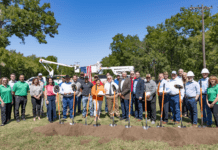While most people know better than to judge a book by its cover, few grant that same courtesy to the buildings these classics call home. On the surface, most public library buildings appear just as they did decades ago, but take a look inside and it’s easy to see this isn’t your parents’ library.
From free internet access to the growing catalog of eBooks, audiobooks and electronic catalogs, libraries in Oklahoma are adapting to the demands of the information age.
“One of the top questions I get is ‘Well how is business at the library?’” Tulsa City-County Library CEO Gary Shaffer says.
“They think business would be going down, but libraries across the country are busier than they’ve ever been. And they’re busier because of technology.”
The driving force behind that technological shift has been the explosion of electronic media. Several libraries across the state have expanded their catalogs to include thousands of downloadable titles available in eBook and audiobook formats.
The Metropolitan Library System of Oklahoma County began offering downloadable eBooks in July 2009. During that first month, the library system had 237 downloads, but has seen that number grow rapidly with more than 14,000 downloads during this past June.
The Tulsa library system has seen a similar climb in the number of eBook downloads, since first offering the format. Usage doubled during the second month to 4,435 downloads in January and has increased 65 percent through the first half of the year.
Although these advances in technology have changed the way we access information, it has not meant a death to public libraries. Metropolitan (OKC) Library System Executive Director Donna Morris says libraries have never been busier, a fact she credits to the poor economy and increased demand for information.
“People are looking for more free material, and a lot of those searching for jobs come into the library for a variety of reasons,” Morris says. “Many companies require applications to be done online, and a lot of people that are out of work probably don’t have access to either a computer or the internet.”
While many parts of the public sector have been hit with budget cuts, public libraries in the state have largely stayed afloat due to stable property taxes and support from lawmakers. That cooperation has been exemplified in Oklahoma City by the construction of a new $8.2 million, 35,000-square-feet Northwest Library, set to open early next year.
“The library pays all the operating costs, and generally we ask the communities to provide and improve the buildings,” Morris says. “And we have worked to raise money for a new library in Choctaw and other communities including the Northwest Library. So we have good cooperation all across the county with our 17, almost 18 libraries.”
Into the modern era
Beginning later next summer, Tulsa’s downtown Central Library will undergo a facelift intended to seriously upgrade the facility and bring it into the 21st century.
Led by the Minneapolis-based architectural firm Meyer Scherer & Rockcastle, the project is anticipated to cost a minimum of $12 million, which will be paid for from the capital fund – money which is set aside for facilities improvements.
The bulk of the funds will pay for infrastructure and mechanical systems, notably including much-needed lighting. Signs and drive-through access are also expected to be improved. In combination with other aspects of the facelift, the project is expected to modernize the 135,000 square-foot library. Several studies in recent years have declared the library mechanical systems obsolete and in need of replacement.
Plans to upgrade the Central Library began to take shape after years of debate and a proposal to construct a new library that failed when voters rejected a 2004 bond issue.
Meyer Scherer & Rockcastle has been responsible for designing more than 160 libraries.
Construction is expected to be completed in spring 2013.


























